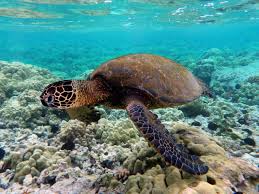Green Sea Turtles

October 28, 2016
I’m sure everyone has heard of the little rhyme “Columbus sailed the ocean blue in 1492.” But not many have heard about the set of islands he also happened to stumble upon in 1503. On those islands were some of the most amazing creatures to have ever been discovered; green sea turtles. These beautiful creatures, by the way, were named this due to the greenish tinge of their fat, not their skin as most seem to think.
Although the discovery of green sea turtles occurred a long time ago, they weren’t officially listed until July 28, 1978. Green sea turtles, although rare in numbers, are found to be in over 140 countries and they are mostly found to be living in the tropical and subtropical waters of the Atlantic Ocean, Indian Ocean, Pacific Ocean, and Mediterranean Sea. Green sea turtles are an olive green color in appearance and can weigh up to 450 pounds on average as adults.They are the largest of the hard-shelled sea turtles, although size, weight, and carapace shape can vary markedly among different populations. This means all green sea turtles weigh about the same, but the way weight is distributed could vary. This depends on how big they are, how heavy their shell is, and what the body shape and shell design is. They’re born with a smooth carapace with four pairs of lateral scutes and a single pair of elongated prefrontal scales between the eyes. Green sea turtles are all born with the same common black carapace, but as they grow older it changes to shades of gray, green, brown, and black in various patterns, except for the Atlantic green turtles, which remain a yellow-ish color.
Green turtles aren’t necessary found in any area where there is water for they only inhabit areas with suitable conditions for them and most importantly, their young. Green sea turtles occupy three types of areas and those are high-energy oceanic beaches, convergence zones in the pelagic habitat, and benthic feeding grounds in relatively shallow, protected waters. Green sea turtles also tend to live near areas with sufficient amounts of food so they’re able to feed and grow properly, and they use places such as coral reefs and rocky outcrops near those feeding pastures at night and during the day as resting areas. In south Florida, and other regions as well, it has been discovered green sea turtles also share their nesting beaches with the threatened loggerhead sea turtle and endangered leatherback sea turtle.
The habits of female green sea turtles are similar to those of other known sea turtles. Female green sea turtles usually swim upshore at night to deposit her eggs. During the breeding season, a female green sea turtle would deposit from one up to seven clutches with 12-14 day intervals. The process also takes up to about an average of two hours. The average number is usually given as two to three clutches, but accurate data on the number of clutches (which refers to all the eggs produced at one time, and often times, laid in a nest), deposited per season are difficult to obtain. Meanwhile, each clutch contains about 110-115 eggs. Female green sea turtles also produce clutches between two or more years of intervals. Very rarely do they produce clutches in successive years.
Green sea turtles are an endangered species, and the decline in their population has been obvious for hundreds of years. There are several reasons for this, but one of the main ones is they have been exploited for food for the longest time. Other than this, it has been recorded juveniles are stuffed as souvenirs, and adults are used for their hide and oil. Another cause is the usage of technology. Because of many technologically advanced tools, turtles can be caught quickly and in large amounts. They can also be caught accidentally such as being trapped in shrimp trawls and then drowned.
Thankfully, many conservation methods have been created to keep these sea creatures from being extinct. One method is the usage of TEDs (or Turtle Excluder Devices) which are used to keep sea turtles out of fishing nets. Although fishermen complain that they lessen the amount of seafood such as fish and shrimp that are caught. TEDs are also protected by laws in many countries such as the Endangered Species Act in the United States. In addition to management of coastal habitats, the National Marine Fisheries Service (NMFS) and the U. S. Fish and Wildlife Service (FWS) have discussed additional conservation measures for the green turtle in the marine environment. So as of now, Green sea turtles are being protected by national and international laws that keep people from harvesting the eggs and young turtles.
Green sea turtles, are beautiful and extravagant creatures that are much bigger than people imagine. They have varying appearances, live in many habitats, have interesting habits, but unfortunately they are endanger of going extinct, which is why many organizations have put in an effort to protecting them. Even though there are many conservation efforts around the world, green sea turtles are still declining in number. So, we must make sure that these creatures don’t go extinct before it’s too late.

